This is the fourth essay of Global China’s “Lost in translation: Decoding Chinese strategic narratives” series. The full collection of essays can be found here.
While on a visit to Heilongjiang Province in September 2023, Chinese President Xi Jinping called on the nation to mobilize “new quality productive forces” (新质生产力) to drive economic growth. He reiterated this message at the annual Central Economic Work Conference in December. And Premier Li Qiang’s annual work report at the National People’s Congress in March 2024 put as its top policy priority “striving to modernize the industrial system and developing new quality productive forces at a faster pace.” In addition, on January 31, a group of seven ministries led by the Ministry of Industry and Information Technology issued a list of “future industries” (未来产业) which are implied to be the major sectoral targets of the “new quality productive forces.”
These slogans culminate a major shift in China’s overall economic policy direction that has been building for two decades, and that has accelerated noticeably in the last five or so years of Xi’s administration. China has now decisively moved away from the growth-maximizing orientation that prevailed from 1979 until the early 2010s, which prioritized systemic reforms to achieve as high a GDP growth rate as possible. The new economic vision prioritizes the acquisition and development of technology—especially “hard” technologies that require a large industrial and manufacturing base. This approach can be seen as a return both to the central tendency of Chinese economic development thinking since the mid-19th century and more specifically, to a Marxist approach to economic policy.
Yet in addition to being the culmination of a long trend toward a technology-centric, industrial policy-driven growth strategy, the shift to “new quality productive forces” marks a change in the focus and methods of Xi’s economic governance. Until recently, Chinese industrial policy’s main aims were to achieve mastery in established technologies and self-sufficiency in key areas in order to resist economic containment efforts by the United States. Now, the aim is to make China a leader in the innovation of new technologies. To achieve this goal, national resources are to be mobilized through a “new national system” (新型举国体制), which implies more centralized control over capital allocation.
The evolution of technology-driven development policies in China
China’s leadership has long seen technology acquisition as the core task of economic and national development. The origins of this view lie in the “Self-Strengthening Movement” (自强运动), launched in the mid-19th century in response to the trauma of China’s defeats in the Opium Wars of 1839-1842 and 1856-1860. The Self-Strengtheners argued that the reason for those defeats lay in the gap in military technology between China and the European colonial powers and that Chinese policy should focus on investments that would close this technological gap. This effort basically failed, in contrast to the roughly contemporaneous Meiji Restoration, which transformed Japan into a modern industrial and military power between 1870 and 1920.
Following the establishment of its government in 1949, the Chinese Communist Party (CCP) has gone through several waves of technology-centered economic development. In the 1950s, with the aid of the Soviet Union, China tried to build up basic industries (notably steel) in a drive that ended with the disastrous Great Leap Forward. In the mid-1970s, economic policymakers launched the “Four Modernizations” (四个现代化) of agriculture, industry, science and technology, and national defense. One specific component of this strategy was a plan to import capital goods and even whole factories in order to accelerate industrial development. This proved impractical due to the lack of hard currency to pay for these imports.
In 1979, economic policy shifted to Deng Xiaoping’s “Reform and Opening” (改革开放), which stressed export-led manufacturing, catalyzed by foreign direct investment, along with systemic reforms to reduce the role of the state and increase reliance on market forces. Although both the “Four Modernizations” and “Reform and Opening” slogans continued to be used into the 1980s, the former gradually receded and Reform and Opening became the central guiding principle.
The next quarter-century had no shortage of industrial policies and technology-acquisition plans, notably the 863 and 973 programs that respectively financed applied and basic scientific research and the “Golden Projects” that drove the deployment of information technology (IT) networks throughout the country and enabled the construction of the “Great Firewall” to insulate the domestic internet from outside influence.
But the distinctive feature of Reform and Opening, relative to other Chinese developmental concepts, was that it put more emphasis on generalized economic progress, and achieving a high rate of GDP growth, than on specific technological goals. Policymakers devoted the most energy to system reforms: increasing the use of market pricing; strengthening rural property rights; creating modern banking and legal systems; lowering tariffs and import barriers; restructuring state-owned enterprises; and integrating with global economic arrangements, particularly the World Trade Organization in 2001.
In 2005, however, Chinese economic policy’s center of gravity began to shift back from these general system reforms to technological development. The starting point was the December 2005 publication of the Medium- and Long-Term Plan for Science and Technology Development (国家中长期科学和技术发展规划纲要), which set out ambitious but vague goals for technological development across a range of sectors. It also introduced the concept of “indigenous innovation” (自主创新), whose precise meaning was the subject of heated debate: Chinese analysts generally portrayed it as a call to increase China’s domestic economic activity, while many Western analysts viewed it as a cover for coercive technology-transfer policies such as domestic standards.
A series of technology- and industrial-policy initiatives followed over the next decade, whose details and cumulative impact have been lucidly laid out by the China economist Barry Naughton. These included:
- 16 “major projects” (重大专项), announced in tandem with the Medium- and Long-Term Plan. These involved direct state investment in projects such as the Beidou (北斗) satellite navigation system, passenger aircraft, hypersonic missiles, and high-end semiconductors and machine tools.
- The Strategic Emerging Industries (战略性新兴产业, SEI) initiative of 2010, which identified seven industries as priorities for investment and development: new-generation IT, biotechnology, high-end equipment, new materials, new energy, new energy vehicles, and energy conservation and environmental protection. An eighth sector, innovative digital technology was added in 2016 and the refined list now comprises at least 20 subsectors.
- Made in China 2025 (中国制造 2025), a 2015 industrial-policy blueprint that came with a range of targets not just for production growth but also for the degree of domestic self-sufficiency and domestic and international market share of China-based firms. The targeted industries were largely though not entirely drawn from SEI sectors.
- The Innovation-Driven Development Strategy (国家创新驱动发展战略纲要) of 2016. This specifies that “By 2050, China shall be established as a world [science and technology] S&T innovation superpower (世界科技创新强国), becoming one of the world’s main centers of science and occupying the high ground in innovation.” It also asserts that “Increases in labor productivity and social productive force (社会生产力) will rely mainly on technological progress and overall innovation.”
New productive forces, future industries, and the new national system
From this background, it can be seen that Xi’s recent advocacy of unleashing “new quality productive forces” to stimulate “future industries” under the guidance of a “new national system” of coordination and capital allocation represents the latest step in a very long trend.
But the new terminology also breaks fresh ground in three areas. First, “new quality productive forces” is a specifically Marxist term, whereas previous industrial policy initiatives had technocratic, ideologically neutral titles. In classical Marxism, “productive forces” refers to the techniques—essentially, labor and capital—that enable things in nature to be converted to objects of human use.
At a Politburo study session on January 31, 2024, Xi asserted that technological innovation is “the core element of developing new productive forces” (科技创新 … 是发展新质生产力的核心要素). In other words, technology is in itself a “new productive force” in addition to the classical ones of labor and capital, and technological innovation can in turn spawn additional “new productive forces.” While we should not overstate the ideological content of Xi’s policies—his economic strategy significantly incorporates market forces as well as state direction—the more open embrace of Marxist terminology serves an important signaling function. It draws a clear distinction between Xi’s economic program and the more explicitly market-oriented consensus of the Reform and Opening period, and it underscores the centrality of the CCP (rather than the government or private sector) in setting the nation’s overall course.
Second, the goal of development using “new quality productive forces” is to generate disruptive breakthroughs, not simply produce incremental improvements on existing technologies. In a January 7 speech at Peking University, former Chongqing mayor Huang Qifan, who is now an influential economic commentator, argued that “‘New quality productive forces’ are not simply ordinary technological progress and marginal improvement; instead they involve disruptive technological innovation that promotes the development of ‘new manufacturing.’” (“新质生产力”并非普通的科技进步和边际上的改进, 而是要有颠覆性的科技创新 … 推动“新制造”的发展).
The implication is that while previous industrial policy efforts mainly focused on achieving competence, self-sufficiency, or global market share in established technologies, the new generation of industrial policies must focus on “future industries” that are nascent or do not yet exist. The need to move the policy targets from the old SEI list to the new “future industries” list is argued in a report from the Chinese Academy of Science.
The official list of “future industries” published by the Ministry of Industry and Information Technology in January spans several broad fields (manufacturing, information, materials, energy, space, and health) and includes items such as humanoid robots, nano-manufacturing, quantum computing, nuclear fusion, hydrogen energy, exploration of the moon and Mars, deep-sea mining, and genetic engineering.
Third, the realization of these vast ambitions requires a “new national system” (新型举国体制) of centralized coordination and financial support. This term has been floating around party documents for many years but became a central part of Xi’s discourse beginning with a speech to the Chinese Academy of Sciences in May 2021. It hearkens back to a centralized “national system” effort to spur technological development following the 1960 Sino-Soviet split and the withdrawal of Soviet technical advisers. The basic concept is that, in a world where China can no longer rely on trade with and investment from other countries (especially the United States) to generate the technology it needs, all available domestic resources must be marshaled to support domestic scientific progress. As suggested by both the SEI and the future industries lists, the range of target sectors is staggeringly broad.
The main mechanisms of the “new national system” are a new Communist Party coordinating body, the Central Science and Technology Commission (CSTC); increased funding for basic scientific research under a competitive grant model; and improved coordination between the public and private sectors via a revamped system of national laboratories and innovation centers, which are increasingly required to collaborate with both private and state-owned companies in what Barry Naughton calls a “consortium” system.
The CSTC is the 10th party commission set up by Xi, and while its membership and specific activities have not been disclosed, it is likely to follow the pattern set by others, such as the Central Cyberspace Affairs Commission (中央网络安全和信息化委员会) and the Central Financial Commission (中央金融委员会). The commissions set broad policy direction and ensure policy compliance while leaving execution to their subordinate government agencies—in the CSTC’s case, the Ministry of Science and Technology. The enhanced public-private cooperation mechanisms are as yet largely aspirational: most of them are organized at the subnational level and their success will depend on the ability of local leaders to reconcile a host of competing commercial and political interests.
There is also likely to be some reform of funding mechanisms. Beginning with the establishment of the National Integrated Circuit Fund in 2014, Beijing promoted a venture capital-like model under which “government guidance funds” raised capital from a variety of public and private sources and invested them in startup technology firms—a model the Economist magazine dubbed the “incubator state.” Predictably, this led to widespread corruption and, arguably, a failure to meet the state’s technology goals. The “new national system” implies that funding will be subject to tighter oversight, but it is as yet unclear how this will work in practice, given that many of the guidance funds remain in operation and a new $40 billion semiconductor fund has recently been launched.
Prospects for success
It is clear that the combination of “new quality productive forces,” “future industries,” and the “new national system” represents another step toward a more centralized, top-down form of economic management, which is more focused on developing specific technologies deemed important by the state than maximizing GDP growth. The new terminology also signals a more unapologetic embrace of Marxist concepts, largely for the purpose of maintaining strategic focus and discipline. But it is important also to note the ways in which it does not represent a simple return to central planning.
For one thing, all of the documents cited in this analysis explicitly recognize that companies are the main drivers of innovation and that market forces have a large role to play; Xi’s Politburo study session remarks, for instance, cite the need to “establish a high-standard market system (建立高标准市场体系).
Xi is also explicit in stating that a criterion for the success of the new productive forces is that they produce “a substantial increase in total factor productivity” (以全要素生产率大幅提升为核心标志). This is an important nod to conventional, non-Marxist economics: Most analyses of China’s recent economic performance from this perspective note that the annual rate of overall (total factor) productivity growth in China has fallen dramatically in recent years, from over 3% in the decades before the global financial crisis in 2008, to around 1% in the subsequent decade, and probably close to zero in the past several years. Pessimistic forecasts of China’s future economic trajectory rest largely on the claim that without strong productivity, it will be impossible for China to sustain fast GDP growth. Xi’s intent is not to ignore the need for economic growth altogether. Rather, he is asserting a theory that rapid economic growth can in fact be achieved by a single-minded pursuit of technological progress: new technologies will create the productivity gains necessary for fast economic growth.
It is too early to say whether this technology-driven development strategy will succeed in generating sustained fast GDP growth. There are certainly good reasons for skepticism, since the large majority of economic activity and employment lies outside the high-tech sectors—notably, in consumer-oriented services. It is far from obvious that success in high-tech hardware will lead to spillovers that boost productivity in the rest of the economy.
But there are good reasons to think that this strategy will produce many technological success stories. For one thing, China’s much-discussed dominance of renewable-energy technologies such as solar, wind, batteries, and electric vehicles is the result of a similar, but much less systematic, industrial policy effort. This success is not isolated. China now accounts for about 20% of the world’s manufactured exports and about 30% of global manufacturing production value; these shares so far have proved resistant to trade “decoupling” efforts led by the United States.
This strong and diverse manufacturing ecosystem, combined with a large and technically skilled workforce, means that more systematic government-led efforts in coordination and basic research are likely to prove fruitful. But China will remain heavily intertwined with the rest of the world economy, both because it will depend on external markets to absorb its inevitable production surpluses, and because even an economy as large as China’s has no hope of completely localizing the intricate supply chains for high-tech goods.

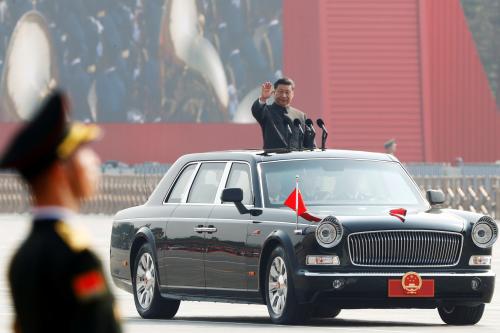
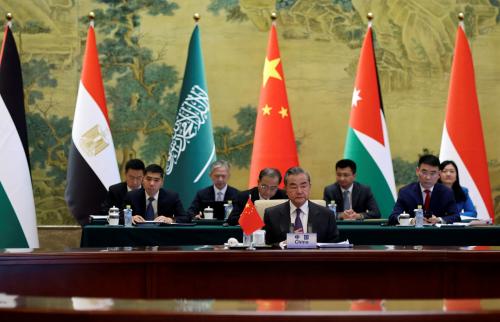
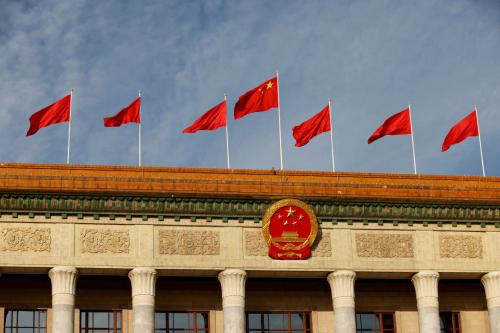
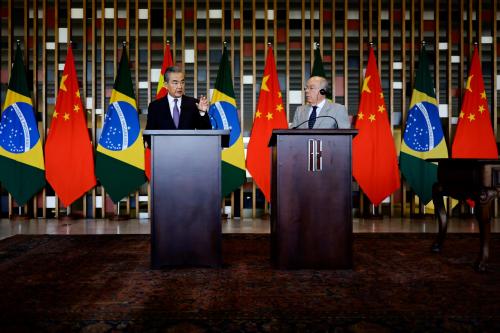
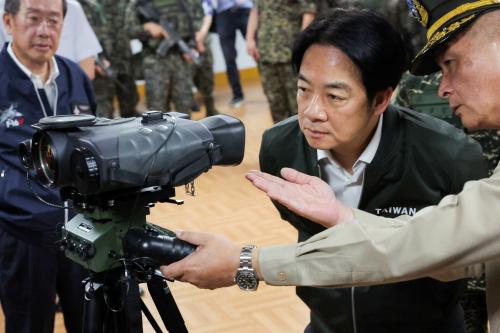
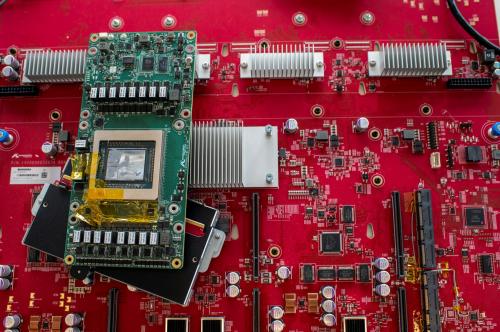
Commentary
Unleashing “new quality productive forces”: China’s strategy for technology-led growth
June 4, 2024